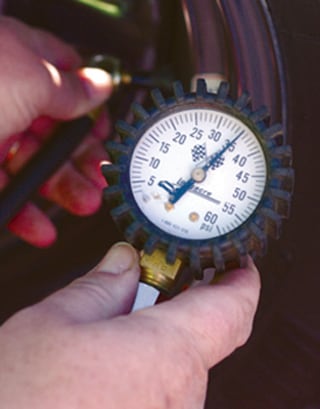
You've seen them many times in your life: tire filling stations with endless loops of hose attached ending in that oddly-shaped, knobby little tip with the strange pin in the middle. They're at gas stations, car washes, and auto shops. If you're not familiar with their proper use and the proper fill pressure for your vehicle's tires you should take the time to learn. It will save you money on tires and gas. Here's what you need to know.
Under-filling and Over-filling
Proper tire pressure preserves the life of your tires. Under-inflating them causes them to ride soft, meaning they flatten too much, as if your vehicle rested upon marshmallows. Tire surfaces not intended to contact the road will do so, resulting in damage to the sidewall areas of the tire.
Over-inflating them makes tires too rigid. The overpressure strains the integrity of the tires and creates increased risk of a rupture. It also leaves less tire surface in contact with the road, resulting in decreased performance.
The Proper Pressure
If you've taken a good look at your car you'll find two sets of fill numbers for the tires. One will be on the rims of the tires. The other will be in the owner's manual and a sticker on the inside of the driver's door. Use the number listed on the sticker for proper fill pressure. The number on the tires is their maximum safe fill pressure. The one on the door is the manufacturer's recommended pressure for proper vehicle and tire performance.
Timing is Everything
Checking your tire pressure is a simple process. It needs to be done at the proper time to give an accurate reading. Always check tire pressure when the tires are cold. That means checking before driving the vehicle, or several hours after it has been stationary. Driving causes friction in the tires, heating the air within them. Warm air expands, giving an inaccurate pressure reading.
Testing, Testing, 1-2-3
Testing tire pressure is quick and easy. For just a few dollars you can purchase a reliable pop-out tire pressure gauge. Remove the plastic cap from the valve stem on the tire. Push the pressure meter stick all the way into the gauge handle. Press the gauge head firmly onto the valve stem with the pin going down into the valve, creating a seal.
There will be a hissing noise and the pressure meter stick will pop out from the gauge handle, showing the pressure of the air inside the tires. Remove the gauge quickly and cleanly. Avoid letting air continue to hiss out of the tire. The number nearest the gauge handle is the current tire pressure.
If you have a more modern gauge the device may use a dial or digital readout instead of a pop-out stick meter.
A quick comparison between the number on the gauge and the number on the sticker on the driver's door will tell the tale. Add air if the pressure is too low; bleed off a little bit of air and re-rest if the pressure was too high. If you had the luck of Goldilocks and the pressure was just right your tire is already properly filled. Simply recap the valve stem and move on to the next tire.
Why Take the Time?
In the end it's about money. Improperly filled tires don't just provide decreased performance. They cause decreased fuel efficiency and tire life as well. Keeping your tires properly filled gets your vehicle more miles per gallon. That translates into fewer expensive visits to the gas pump. It also makes your tires last longer, giving you more time between tire replacements.
Keeping your tires properly inflated is the proverbial "stitch in time." A little time invested now will make your car perform better, save you money on annual gas expenses, and give your tires a longer useful life.
